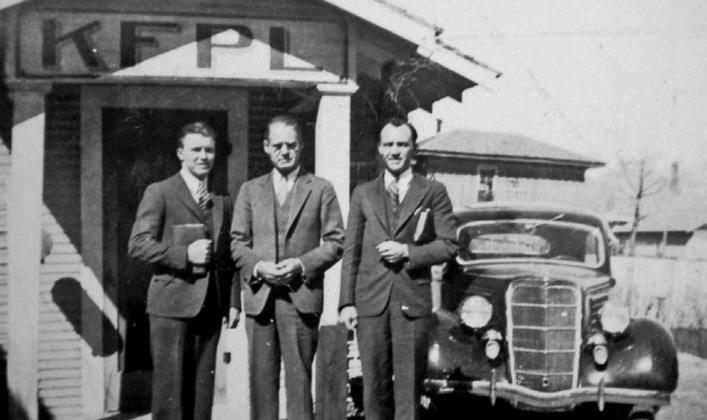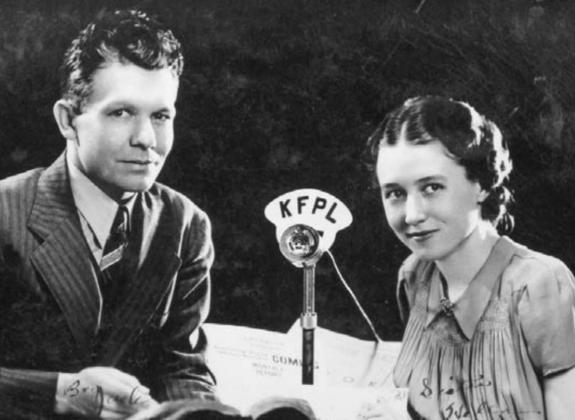Radio in Dublin, may have started with Guy Neel, the son of the editor of the Dublin Telephone newspaper. He started experimenting with sending and receiving radio transmissions as early as 1909 and 1910 with his state of the art equipment. It consisted of a loose coupler, some Murdock variable condensers and a crystal detector.
Some years later, Mr Neel participated in a radio reception experiment and received radio messages from ships in the Pacific and Atlantic on his radio setup. Each ship sent one half of the final message. Neel took both of the messages to the mayor of Dublin, Dennis Sheehan, who signed a postal card receipt showing the hour received. It was mailed to the central radio station at Rock Island, Illinois. It proved that wireless was a usable form of communication. (Dublin Progress, February 25, 1921)
Seeing what Neel and others were doing, C. C. Baxter became fascinated with radio. He started a radio club where members could learn to build and operate radio equipment. Speakers talked about operating spark gap and continuous wave transmitters. Baxter also started a radio club where young men were taught how to make a crystal radio so they could listen to broadcasts. (Dublin Progress, October 20, 1922, March 16, 1923)
Soon afterwards, the Dublin Progress made an announcement that C. C. Baxter had installed a broadcast radio station, license No. 1400 limited commercial class A which will be operated by C. B. Baxter commercial operator. “This station is the outgrowth of the old 5IR station that was the first station operated by C. B. Baxter. Station KFPL, one of the first stations in the country, has been installed at much expense and deserves the support of every citizen.” (Dublin Progress, April 18, 1924)
The station started with a broadcast power of just 15 watts. That does not sound like much power, but early in radio history, there were not many stations on the air, so a small amount of power would go a long way. It is said that KFPL started in the back of the Baxter’s Place store. It later moved to the new KFPL building located behind C. C. Baxter’s house on Grafton St. The station had four studios. Two broadcast towers were built next to Baxter’s house by Harry Warner. The two towers looked much like large windmill towers, with wires strung between them. (Covered Wagons Keep on Rollin’, Westphal, p197.)
The playing of 78 records on radio was frowned upon because of the poor quality. So most early radio stations had programming of live music. Larger stations often had their own orchestras. Smaller stations had to find music groups in their communities. KFPLs programming the last week of April 1924 got many, many phone calls. Their broadcast featured the orchestra of the First Baptist Church of Stephenville. Then the Rev. S. B. Culpepper spoke with his address “What are you worth?” Phone calls came in from as far as Fort Worth saying the quality of the program was excellent. (Dublin Progress May 2, 1924)
Just weeks after KFPL went on the air the Hasse String Band played for listeners. Hasse spokesman, Rev. Walter Martin said “If Dublin would build a cement bridge across the Leon between Hasse and Dublin, then Hasse would allow Dublin to take her in under her incorporated limits.” (Dublin Progress, May 9, 1924)
Then the January 1, 1937 The Dublin Progress, announced that the broadcast power of KFPL was being increased to 250 watts. These broadcast signals would sometimes bounce off the ionosphere. This “skip” could take radio signals vast distances. At one point the KFPL signal was received in New Zealand. (Covered Wagons Keep on Rollin’, Westphal, p196)
A new radio hookup was made by Arch Evans of the Stephenville Tire Store. They were providing programming on each weekday morning and on Sunday mornings under the title of the “Stephenville Studios of KFPL.” On the initial broadcast Mayor Henry Clark said that it would fill a long felt need in Stephenville. The Tarleton College Orchestra composed of cadet students and directed by Morton P. Brooks then gave a short concert. (Dublin Progress, December 2, 1938)
Religious programming was always popular at that time. A number of pastors passed through the KFPL studios. Brother Jack Hathaway, pastor of the Brush Arbor Church stated his congregation was holding a one hour singing program Thursday night on KFPL. During the program a girl would be given a doll and a boy would be given an air-rifle. (Dublin Progress, December 20, 1940)
As World War II approached, the station had a problem. As soon as they would train men to operate the station, they would be called away for military duty. Then the headline appeared in the July 15th, 1942 Brownwood Bulletin, “License of KFPL, Dublin, canceled at owner’s request” ”The action was taken at the request of the licensee, C. C. Baxter, who said he was unable to obtain operators and equipment to continue operation of the station, one of the oldest in the country.” (Brownwood Bulletin, July 15, 1942)
Many in Dublin thought that it was just another business shutting down that would return after the war. It did not return. For listeners, there was a vacuum left by KFPL’s absence. That vacuum would be filled by a station in Stephenville, KSTV. It started operations the next year, 1943.


